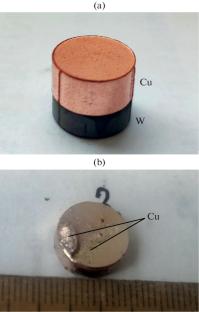自蔓延高温合成与渗渗相结合制备W-Cu伪合金
IF 0.3
Q4 MATERIALS SCIENCE, MULTIDISCIPLINARY
引用次数: 0
摘要
研究了以氮为热源,利用硅燃烧的高放热反应,采用渗透法制备钨铜伪合金的可能性。在燃烧放出热量的作用下,用铜浸渍多孔钨骨架。合成了相对密度为0.9的伪合金。本文章由计算机程序翻译,如有差异,请以英文原文为准。

Combination of Methods of Self-Propagating High-Temperature Synthesis and Infiltration to Obtain W–Cu Pseudo-Alloy
The possibility of synthesis of a tungsten–copper pseudo-alloy by the infiltration method in the highly exothermic reaction of combustion of silicon in nitrogen as a heating source has been studied. Under the action of heat released during combustion, the porous tungsten frame was impregnated with molten copper. The pseudo-alloys with a relative density of 0.9 was synthesized.
求助全文
通过发布文献求助,成功后即可免费获取论文全文。
去求助
来源期刊

Inorganic Materials: Applied Research
Engineering-Engineering (all)
CiteScore
0.90
自引率
0.00%
发文量
199
期刊介绍:
Inorganic Materials: Applied Research contains translations of research articles devoted to applied aspects of inorganic materials. Best articles are selected from four Russian periodicals: Materialovedenie, Perspektivnye Materialy, Fizika i Khimiya Obrabotki Materialov, and Voprosy Materialovedeniya and translated into English. The journal reports recent achievements in materials science: physical and chemical bases of materials science; effects of synergism in composite materials; computer simulations; creation of new materials (including carbon-based materials and ceramics, semiconductors, superconductors, composite materials, polymers, materials for nuclear engineering, materials for aircraft and space engineering, materials for quantum electronics, materials for electronics and optoelectronics, materials for nuclear and thermonuclear power engineering, radiation-hardened materials, materials for use in medicine, etc.); analytical techniques; structure–property relationships; nanostructures and nanotechnologies; advanced technologies; use of hydrogen in structural materials; and economic and environmental issues. The journal also considers engineering issues of materials processing with plasma, high-gradient crystallization, laser technology, and ultrasonic technology. Currently the journal does not accept direct submissions, but submissions to one of the source journals is possible.
 求助内容:
求助内容: 应助结果提醒方式:
应助结果提醒方式:


